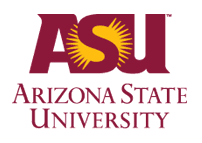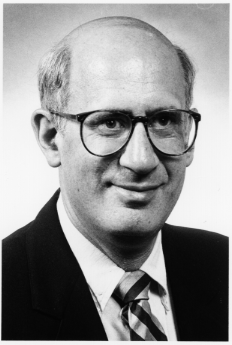
Teacher of the Month--
Kenneth Mossman |
 |
For 25 years Dr. Mossman has taught
undergraduate level courses primarily in radiological health. Mossman said he believes in engaging his students in active learning."I believe teachers do not teach, but create an environment whereby students learn," he said. A former student seems to agree with his philosophy, "Dr. Mossman is an encouraging and enthusiastic professor. He excites critical thinking and knows his field very well."
STATEMENT OF KENNETH L. MOSSMAN
A. Philosophy of Teaching
I have been teaching at the undergraduate level for almost 25 years. During that time I have developed a philosophy of teaching based on the belief that: (1) teachers do not teach but create an environment whereby students learn and, (2) although formal c
lassroom instruction is an important part of the learning process, students primarily learn outside the classroom.
Based on these basic tenets, I have adopted and continue to practice the following principles of good teaching:
- Teachers must have a broad theoretical and working knowledge of the discipline. Knowledgeable professors can bring important insights to the classroom that may be missing from textbooks or unimaginative lecture notes. Framing difficult concepts in a meaningful way enhances student learning. Use of creative learning tools, ncluding audio/visual aids and case studies, can greatly enhance the learning experience if used in proper balance.
- Courses should have a well defined structure that provides the educator with an organizational basis for instruction and the student with an organizational basis for learning. Poorly organized lectures and courses are an impediment to learning.
- Instructors must be enthusiastic and interested in the teaching enterprise. Disinterested and unenthusiastic faculty are generally ineffective because students are not encouraged to learn. Interest and enthusiasm are contagious and create an effective learning environment even for the most difficult subject matter.
- The key to an effective and meaningful course is the development of a small number of "themes" or "principles" which form a common thread and interconnect all of the lectures. I present course themes in the first lecture and reinforce them throughout the course. The themes are the take-home messages. My goal is that after 5 years every student should be able to recall the course themes. Effective and meaningful themes are likely to be remembered but specific details presented in class may not be. Effe
ctive themes bridge specific course topics with experiences in every day life. For instance, one theme in my "Cancer and Heart Disease" course is that strategies to prevent disease are preferable to strategies to treat disease. This theme is similar to the adage "an ounce of prevention is worth a pound of cure."
- Students learn by being active rather than being passive. Students should be encouraged, based on the size and nature of the course, to participate in small projects or make brief presentations in class. Every course should sharpen students' critical thinking skills by challenging them with problems, papers, or individual/group projects involving the synthesis of concepts and facts. The instructor's commitment to working with students on an individual or small group basis is critical to the success of the students' learning experience.
- Faculty should not limit instructional activities to classroom lectures. Encouraging students to visit with faculty out of class enhances learning and shows genuine interest in the students.
B. Agenda for Continued Teaching Development and Innovation
1. Course Development Using the Case Study Method
For the past 15 years, I have employed the case study approach in some of my lectures. Discussing concepts and issues, and solving problems using real world examples is an effective instructional tool. In the past, I have used this method sparingly but have come to realize that it may be applicable in a much wider spectrum of teaching situations. I am now collecting background material for case studies in certain topical areas (e.g., food irradiation). Developing effective cases for discussion and classroom presentation will require careful background research and development of applicable instructional aids. My goal is to develop a "library" of case studies to illustrate course principles in a way that relates to most students experiences. Few faculty members in the life sciences use this approach. It has been used successfully in business and medical education for many years.
2. ASU Faculty Development
The case study approach can be incorporated, to varying degrees, in courses in almost all disciplines. I would like to work with the ASU Faculty Development Office and the colleges to develop a case study program. Such a program would assist faculty in developing case studies for their courses. The program may also serve as a repository for case studies that other faculty members could share. Case studies would be developed in a generic format to facilitate adoption in specific courses.
Back to Top
Curriculum Vitae - Kenneth Mossman
RÉSUMÉ HIGHLIGHTING TEACHING ACTIVITIES AND CONTRIBUTIONS
Kenneth L. Mossman is a nationally-recognized lecturer/educator. The following summary of awards and accomplishments reflect continued and sustained excellence in teaching and education:
A. Contributions Recognized Nationally
1. Development of Innovative Slide Programs as Instructional Aids
Kenneth L. Mossman is the author and creator of 4 revolutionary slide programs used as supplemental learning materials in college-level physics and biology courses (see references #2 through #8 under "Scholarly Works..." below). These programs were revolutionary in two ways. First, they were among the first educational visuals to utilize computer-imaging graphics (early 1980s). At the time, the slides were created on a mainframe computer. Today, images are readily created on a desktop. Second, the slide programs were specifically designed to supplement a wide spectrum of educational materials in physics and biology. Slides are generic in nature and can be mixed and matched with other educational aids available to the instructor. Most visual aids have limited course applicability. These slide programs and instructor's guides were developed to allow instructors to enhance the usefulness of other teaching materials in a wide spectrum of courses. Examples of slides and an "Instructor's Guide" are included with this nomination package.
2. Elda Anderson Award
In 1984, Dr. Mossman was awarded the prestigious Elda E. Anderson Award from the Health Physics Society (the largest radiation protection organization in the world). The award is given to a young health physicist (40 years of age or younger) who has made significant educational or other contributions to the field. Specifically the award citation addressed the development of the slide programs discussed above:
"These slide programs, the first of their kind, were developed using the most up-to-date computer graphics techniques and are being used all over the world by various utilities, universities ,and medical centers. More than 50 colleges and universities in the United States presently use these programs. "
The award citation also recognized contributions to graduate education (at Georgetown University, Washington, DC), and activities on education committees (in the radiation sciences) at the national level.
The complete award citation may be found in Health Physics 47: 689-692; 1984.
3. Sigma Xi Distinguished Lecturer
Dr. Mossman has been elected to serve as a Sigma Xi Distinguished
Lecturer for 1996-1997 and 1997-1998 in recognition of scholarship and outstanding lecturing abilities. Individuals who are at the leading edge of science and who can communicate their insights and excitement to a broad range of scholars are selected to serve in the College of Distinguished Lecturers (see American Scientist 83(6): 589-596; 1995). Dr. Mossman was one of twenty-eight (28) scientists and educators chosen from around the country. He is only the second ASU professor to be so honored since the inception of the program 60 years ago.
B. Community Service
Dr. Mossman's commitment to undergraduate education extends beyond the classroom and university campus. He is actively engaged in precollege science education activities to encourage high school students to pursue careers in science and engineering and to prepare students for the college experience. As president of the Health Physics Society, Dr. Mossman was instrumental in obtaining a $250,000 education grant from the U.S. Department of Energy (granted to the Health Physics Society) to fund science teacher workshops around the country. The purpose of these workshops was to introduce nuclear science experiments to teachers, to renew enthusiasm for science teaching, and to provide teachers with innovative classroom demonstration experiments as a means of increasing student interest in science.
Dr. Mossman is the Director of the Central Arizona Regional Science and Engineering Fair (CARSEF), the largest science fair for high school students in the state of Arizona. Each year over 300 students submit exhibits in 14 categories in science and engineering. As Director, Dr. Mossman works closely with science teachers in Maricopa and four surrounding counties to encourage teacher and student interest in science. Dr. Mossman has visited several school in the Phoenix metropolitan area to talk about the fair.
Dr. Mossman is an active member of the College of Liberal Arts and Sciences' Faculty Ambassadors Program. At the request of teachers, he visits high schools in the Phoenix metropolitan area to talk about undergraduate education in the sciences at ASU and to answer questions about professional health careers.
C. Teaching Activities at ASU
Dr. Mossman's teaching activities at ASU are strictly devoted to undergraduate classes and individual students. During the past three years Dr. Mossman has taught the following:
Fall 1993
BIO 394: Radiation Medicine and Biology, 3 credits, 9 students
MIC 191: Freshman Seminar: Cancer in America, 1 credit, 5 students
MIC 206: Microbiology Laboratory, 1 credit, 180 students
MIC 493: Honors Thesis, 1 credit, 1 student
MIC 499: Independent Study, 1 credit, 1 student
Spring 1994
BIO 394: Cancer and Heart Disease, 3 credits, 60 students
BIO 494: Radiation and Life, 3 credits, 17 students
MIC 206: Microbiology Laboratory, 1 credit, 180 students
Fall 1994
BIO 394: Cancer and Heart Disease, 3 credits, 46 students
BIO 499: Independent Study, 3 credits, 1 student
BME 461: Health Physics Principles, 3 credits, 8 students
MIC 206: Microbiology Laboratory, 1 credit, 180 students
Spring 1995
BIO 494: Radiation and Life, 3 credits, 13 students
MIC 205: Microbiology, 3 credits, 118 students
MIC 206: Microbiology Laboratory, 180 students, 1 credit
MIC 401: Research Paper, 1 credit, 1 student
MIC 492: Honors Directed Study, 1 credit, 1 student
Fall 1995
BIO 360 Cancer and Heart Disease, 3 credits, 30 students
BIO 494: Radiation Medicine and Biology, 3 credits, 11 students
MIC 206: Microbiology Laboratory, 1 credit, 194 students
MIC 492: Honors Directed Study, 1 credit, 1 student
Spring 1996
BIO 361: Radiation and Life, 3 credits, 35 students
MIC 205: Microbiology, 3 credits, 112 students
MIC 401: Research Paper, 1 credit, 1 student
MIC 492: Honors Directed Study, 1 credit, 1 student
D. Honors
| 1996-97 | Sigma Xi Distinguished Lecturer |
| 1995 | Marie Curie Gold Medal Award, Health Physics Society |
| 1994- | Fellow, Health Physics Society |
| 1993-94 | President, Health Physics Society |
| 1986- | Member, Cosmos Club, Washington, D.C. |
| 1984 | Elda E. Anderson Award, Health Physics Society |



